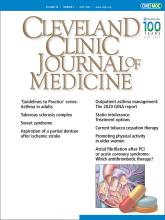
In this issue, Kommaraju and Latifisummarize highlights from the 2020 GINA (Global Strategy for Asthma Management and Prevention) guidelines for the management of asthma in adult patients. This article is part of our ongoing series “Guidelines to Practice,” shepherded by CCJM deputy editor Dr. Pelin Batur.
Recent years have seen a proliferation of practice guidelines put forth by specialty societies and various working groups. Practicing clinicians have found some to be useful in that they represent an evidence-based list of diagnostic and management suggestions, providing a summary of data on topics that we may not have had the opportunity to review ourselves. But there have been concerns that payers may use guidelines to limit payment for tests or therapies that were not specifically recommended or were specifically discouraged. Physicians bristle at this, but theoretically, and hopefully in reality, the reasonable exceptions to published guidelines for specific patient circumstances can be justified and resolved. As almost all guidelines state somewhere in small print, guidelines are only guidelines and are not meant to encompass all scenarios.
The goal of the “Guidelines to Practice” series is to briefly and concisely outline how a specific guideline fits in the context of current clinical practice and how it compares with previous guidelines. This is important, because not all guidelines on the same topic are in agreement. Publication of new studies and availability of new therapies necessitate revisiting older guidelines. Sometimes the rules for generating a new set of guidelines differ from older ones. Some consider cost while others do not, arguing that regional economies differ and the marketplace changes. Some have strict rules regarding the incorporation of data used in the writing of the guideline, allowing only prospective randomized trials and excluding observational and preclinical data. So not all guidelines are created equal, and we ask authors of “Guidelines to Practice” articles to point out these differences, when relevant, and to highlight the practical and newer conceptual aspects of the guidelines.
The GINA document emphasizes a key concept in the management of asthma in adults: asthma is an inflammatory syndrome, with bronchospasm manifesting as wheezing or cough. Hence, for moderate disease activity or even for mild intermittent disease with flares, inhaled corticosteroid therapy should be considered in conjunction with a long-acting beta-agonist. We have all had patients in whom very intermittent use of short-acting beta-agonists has been sufficient to control their symptoms over many years, and this approach may remain reasonable for some of these patients. But as highlighted in the reasoned summary of the GINA report, the goal of co-therapy with inhaled corticosteroids and long-acting bronchodilators is to prevent severe exacerbations and even death from asthma, particularly in newly diagnosed patients in whom a track record of response to therapy has not been established.
- Copyright © 2021 The Cleveland Clinic Foundation. All Rights Reserved.






